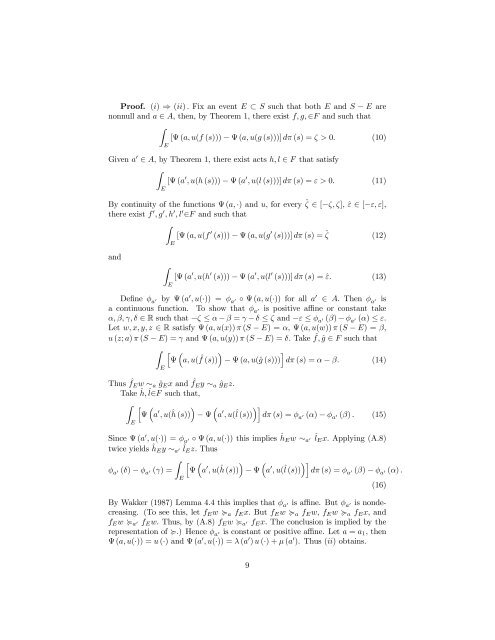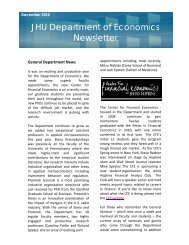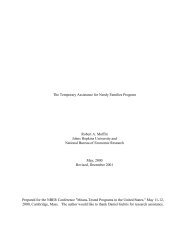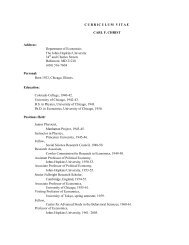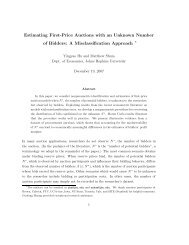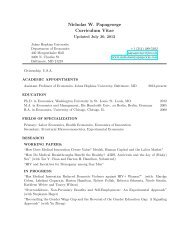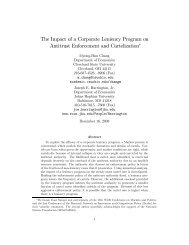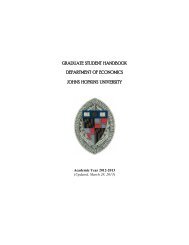Subjective Expected Utility Theory with Costly Actions - Economics ...
Subjective Expected Utility Theory with Costly Actions - Economics ...
Subjective Expected Utility Theory with Costly Actions - Economics ...
Create successful ePaper yourself
Turn your PDF publications into a flip-book with our unique Google optimized e-Paper software.
Proof. (i) ) (ii) : Fix an event E ½ S such that both E and S ¡ E are<br />
nonnull and a 2 A; then, by Theorem 1, there exist f;g;2F andsuchthat<br />
Z<br />
[ª (a; u(f (s))) ¡ ª(a; u(g (s)))] d¼ (s) =³>0: (10)<br />
E<br />
Given a0 2 A; by Theorem 1, there exist acts h; l 2 F that satisfy<br />
Z<br />
[ª (a<br />
E<br />
0 ;u(h (s))) ¡ ª(a 0 ;u(l (s)))] d¼ (s) =">0. (11)<br />
By continuity of the functions ª(a; ¢) and u; for every ^ ³ 2 [¡³;³]; ^" 2 [¡"; "];<br />
there exist f 0 ;g 0 ;h 0 ;l 0 2F and such that<br />
and<br />
Z<br />
Z<br />
[ª (a; u(f<br />
E<br />
0 (s))) ¡ ª(a; u(g 0 (s)))] d¼ (s) = ^ ³ (12)<br />
[ª (a<br />
E<br />
0 ;u(h 0 (s))) ¡ ª(a 0 ;u(l 0 (s)))] d¼ (s) =^". (13)<br />
De…ne Á a 0 by ª(a 0 ;u(¢)) = Á a 0 ± ª(a; u(¢)) for all a 0 2 A: Then Á a 0 is<br />
a continuous function. To show that Á a 0 is positive a¢ne or constant take<br />
®; ¯; °; ± 2 R such that ¡³ · ® ¡ ¯ = ° ¡ ± · ³ and ¡" · Á a 0 (¯) ¡ Á a 0 (®) · ":<br />
Let w; x; y; z 2 R satisfy ª(a; u(x)) ¼ (S ¡ E) =®; ª(a; u(w)) ¼ (S ¡ E) =¯;<br />
u (z; a) ¼ (S ¡ E) =° and ª(a; u(y)) ¼ (S ¡ E) =±: Take ^ f;^g 2 F such that<br />
Z<br />
E<br />
h ³<br />
ª a; u( ^ ´<br />
i<br />
f (s)) ¡ ª(a; u(^g (s))) d¼ (s) =® ¡ ¯: (14)<br />
Thus ^ fEw »a ^gEx and ^ fEy »a ^gEz:<br />
Take ^ h; ^ l2F such that,<br />
Z<br />
E<br />
h ³<br />
ª a 0 ;u( ^ ´ ³<br />
h (s)) ¡ ª a 0 ;u( ^ ´i<br />
l (s)) d¼ (s) =Áa0 (®) ¡ Áa0 (¯) : (15)<br />
Since ª(a 0 ;u(¢)) = Á a 0 ± ª(a; u(¢)) this implies ^ hEw »a 0 ^ lEx: Applying (A.8)<br />
twice yields ^ hEy »a0 ^lEz: Thus<br />
Z<br />
Á a 0 (±) ¡ Á a 0 (°) =<br />
E<br />
h ³<br />
ª a 0 ;u( ^ ´ ³<br />
h (s)) ¡ ª a 0 ;u( ^ ´i<br />
l (s)) d¼ (s) =Áa0 (¯) ¡ Áa0 (®) :<br />
(16)<br />
By Wakker (1987) Lemma 4.4 this implies that Á a 0 is a¢ne. But Á a 0 is nondecreasing.<br />
(To see this, let fEw


